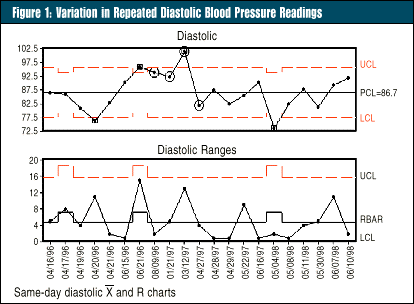|
Anyone who has spent time using statistical process control has encountered measurement error. This occurs when we apply a measurement system to a single object and get different results. We measure voltage or pH reading two or three times in rapid succession and get two or three different numbers.
Such variation occurs in health care measurements, too. Visit your neighborhood pharmacy, and you are likely to find an instrument that allows you to check your blood pressure on the spot. If you stand near one of these machines for a while, you inevitably hear someone say, "It says my blood pressure is high, but it varies so much that it doesn't mean anything."
Measurement variation in health care is even more slippery than in manufacturing, where we at least know we are measuring the same thing repeatedly. In health care, this isn't the case. We know, for example, that blood pressure does change constantly. The so-called white coat effect can cause a person's blood pressure to rise simply because he or she is nervous about having a doctor or nurse measure it.
A few years ago, I conducted a blood pressure measurement study for a hospital client. During the study, I discovered that my own blood pressure was quite high, so I paid a visit to my doctor. I also invested in a self-test instrument so I could monitor my own blood pressure.
To establish a baseline, I checked my blood pressure for several days prior to seeing my doctor. Then I took my blood pressure machine with me to measure the white coat effect. Sure enough, the doctor's and nurse's readings were higher than my home readings, by nearly 20 points. (All readings referred to here are diastolic.) When I asked the doctor to use my home-testing device on me, it also showed a 20-point rise. This fact, combined with the run chart I'd brought, proved very useful to my doctor. As a result, he prescribed a much less radical treatment regimen.
Over the next several years, I monitored my blood pressure as I experimented with ways to bring it down. In Figure 1, The R chart indicates the variation between multiple readings taken on the same day. The average and control limits zigzag because sometimes I checked my blood pressure twice and sometimes three times on a given day. According to the R chart, if I check my blood pressure twice in one day, I can expect to see an average difference of about five points and a maximum of about 15. If I check it three times, the average difference will be about seven points with a maximum of about 17 points.

Doctors are very data-oriented. They are accustomed to evaluating data from test results and using these data to help them diagnose a patient's condition and evaluate treatment effectiveness. However, doctors tend to look at points of data rather than patterns and trends. I put my significant test results in a spreadsheet and show their run charts to my doctor. Now doctor visits tend to be more of a dialog on how to best improve my health rather than a one-way communication.
Managers also tend to focus on the most recent result rather than on patterns and trends. Better managers use data to determine what needs to be done and to evaluate their past actions' effectiveness. Showing them control or run charts helps them put the data into a context and focus discussions on facts rather than personalities and opinions.
Properly done, the result will be improved processes, whether business or biological.
About the author
Thomas Pyzdek is president and CEO of Pyzdek Management Inc. He has authored 13 books, including The Complete Guide to the CQM. Comments can be e-mailed to him at Tom Pyzdek. | 
